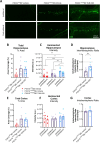Glymphatic inhibition exacerbates tau propagation in an Alzheimer's disease model
- PMID: 38576025
- PMCID: PMC10996277
- DOI: 10.1186/s13195-024-01439-2
Glymphatic inhibition exacerbates tau propagation in an Alzheimer's disease model
Erratum in
-
Correction: Glymphatic inhibition exacerbates tau propagation in an Alzheimer's disease model.Alzheimers Res Ther. 2024 Nov 28;16(1):258. doi: 10.1186/s13195-024-01624-3. Alzheimers Res Ther. 2024. PMID: 39605000 Free PMC article. No abstract available.
Abstract
Background: The aggregation and spread of misfolded amyloid structured proteins, such as tau and α-synuclein, are key pathological features associated with neurodegenerative disorders, including Alzheimer's and Parkinson's disease. These proteins possess a prion-like property, enabling their transmission from cell to cell leading to propagation throughout the central and peripheral nervous systems. While the mechanisms underlying their intracellular spread are still being elucidated, targeting the extracellular space has emerged as a potential therapeutic approach. The glymphatic system, a brain-wide pathway responsible for clearing extracellular metabolic waste from the central nervous system, has gained attention as a promising target for removing these toxic proteins.
Methods: In this study, we investigated the impact of long-term modulation of glymphatic function on tau aggregation and spread by chronically treating a mouse model of tau propagation with a pharmacological inhibitor of AQP4, TGN-020. Thy1-hTau.P301S mice were intracerebrally inoculated with tau into the hippocampus and overlying cortex, and subsequently treated with TGN-020 (3 doses/week, 50 mg/kg TGN-020, i.p.) for 10-weeks. During this time, animal memory was studied using cognitive behavioural tasks, and structural MR images were acquired of the brain in vivo prior to brain extraction for immunohistochemical characterisation.
Results: Our findings demonstrate increased tau aggregation in the brain and transhemispheric propagation in the hippocampus following the inhibition of glymphatic clearance. Moreover, disruption of the glymphatic system aggravated recognition memory in tau inoculated mice and exacerbated regional changes in brain volume detected in the model. When initiation of drug treatment was delayed for several weeks post-inoculation, the alterations were attenuated.
Conclusions: These results indicate that by modulating AQP4 function and, consequently, glymphatic clearance, it is possible to modify the propagation and pathological impact of tau in the brain, particularly during the initial stages of the disease. These findings highlight the critical role of the glymphatic system in preserving healthy brain homeostasis and offer valuable insights into the therapeutic implications of targeting this system for managing neurodegenerative diseases characterized by protein aggregation and spread.
Keywords: Glymphatic; MRI; Neurodegeneration; Propagation; Tau.
© 2024. The Author(s).
Conflict of interest statement
The authors declare no competing interests.
Figures





References
-
- Ahmed Z, Cooper J, Murray TK, Garn K, McNaughton E, Clarke H, Parhizkar S, Ward MA, Cavallini A, Jackson S, Bose S, Clavaguera F, Tolnay M, Lavenir I, Goedert M, Hutton ML, O’Neill MJ. A novel in vivo model of tau propagation with rapid and progressive neurofibrillary tangle pathology: the pattern of spread is determined by connectivity, not proximity. Acta Neuropathol. 2014;127:667–83. - PMC - PubMed
-
- Allen B, Ingram E, Takao M, Smith MJ, Jakes R, Virdee K, Yoshida H, Holzer M, Craxton M, Emson PC, Atzori C, Migheli A, Crowther RA, Ghetti B, Spillantini MG, Goedert M. Abundant tau filaments and Nonapoptotic Neurodegeneration in transgenic mice expressing human P301S tau protein. J Neurosci. 2002;22:9340. - PMC - PubMed
-
- Ameen-Ali KE, Easton A, Eacott MJ. Moving beyond standard procedures to assess spontaneous recognition memory. Neurosci Biobehav Rev. 2015;53:37–51. - PubMed
-
- Bergamini G, Sigrist H, Ferger B, Singewald N, Seifritz E, Pryce CR. Depletion of nucleus accumbens dopamine leads to impaired reward and aversion processing in mice: relevance to motivation pathologies. Neuropharmacology. 2016;109:306–19. - PubMed
Publication types
MeSH terms
Substances
Grants and funding
LinkOut - more resources
Full Text Sources
Medical
Miscellaneous

